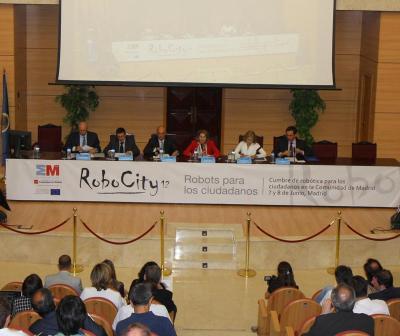The event, "RoboCity12: Robots para los ciudadanos" (Robots for the people), hosted by the Escuela Técnica Superior de Ingenieros Industriales (School of Industrial Engineering - ETSII) of the Universidad Politécnica de Madrid (UPM), gathered nearly 40 robots "made in Spain" for two days. The objective was to present the most recent advances in robotics that have been developed in the Community of Madrid, as well as the main innovations that have appeared on the national and international scenes.

Robotics is an area of research that can help us to innovate and become more competitive in the international marketplace. This was one of the conclusions of RoboCity12, the Robotics Summit that was recently held in Madrid by RoboCity2030, a consortium coordinated by Universidad Carlos III of Madrid, which is made up of the strongest groups doing research in this area from the Autonomous Community of Madrid.
(Photo Credit: UC3M)
This Robotics for the People summit conceived with the idea of becoming a national meeting point for a scientific field that holds great potential for bringing about benefits to society, through personal assistance robots, infrastructure maintenance devices, medical robotics, public safety inventions, etc. "Robotics is synonymous with progress and technological development", state the organizers, who explain that countries that use robots extensively not only enjoy extraordinary gains in competitiveness and productivity, but they also have lower rates of unemployment and they transmit an image of modernity.
"In short, this is about involving society in the themes related to robotics", concludes the coordinator of RoboCity2030, UC3M professor Carlos Balaguer, who participated in the event's opening ceremony, together with the UPM Chancellor, Carlos Conde, and UPM's Vice-Chancellor of Structural Organization and Quality, Sara Gómez; the Assistant General Director of Research of the Community of Madrid, Juan Ángel Botas; The General Director of the Center for Technological and Industrial Development, Elisa Robles; the Director of the ETSSI, Jesús Félez; and the representative of the Spanish Technological Platform for Robotics (HISPAROB), Pablo González. Afterward, Paolo Darío, professor of Biomedical Robotics at the Scuola Superiore Sant´Anna (Pisa, Italia) gave a talk on the robotics of the future, in which he advocated engineering that would be closely interconnected with science. In addition, he detailed the potential that robotics holds for applications in situations such as forest fires or natural disasters, or as tools that can be used as we face the demographic challenges posed by our aging populations. Finally, he explained the possibilities presented by "neuro-robotics", a growing area of research created by the merging of robotics and neuroscience.
More robotics, less unemployment
Through talks and demonstrations, several different areas in which robotics plays an important role in helping people were shown. In addition to the devices presented by the public research centers, some of the most innovative robotics companies were present in the area of display stands, where they showed the public the most recent developments and gave a further view of the latest trends in the field. Among the firms present were: ABB, SCHUNK, ROBOTNIK, ADELE ROBOTS, FANUC, MINIROBOTS, DEIMOS SPACE, etc.
Source: Carlos III University of Madrid